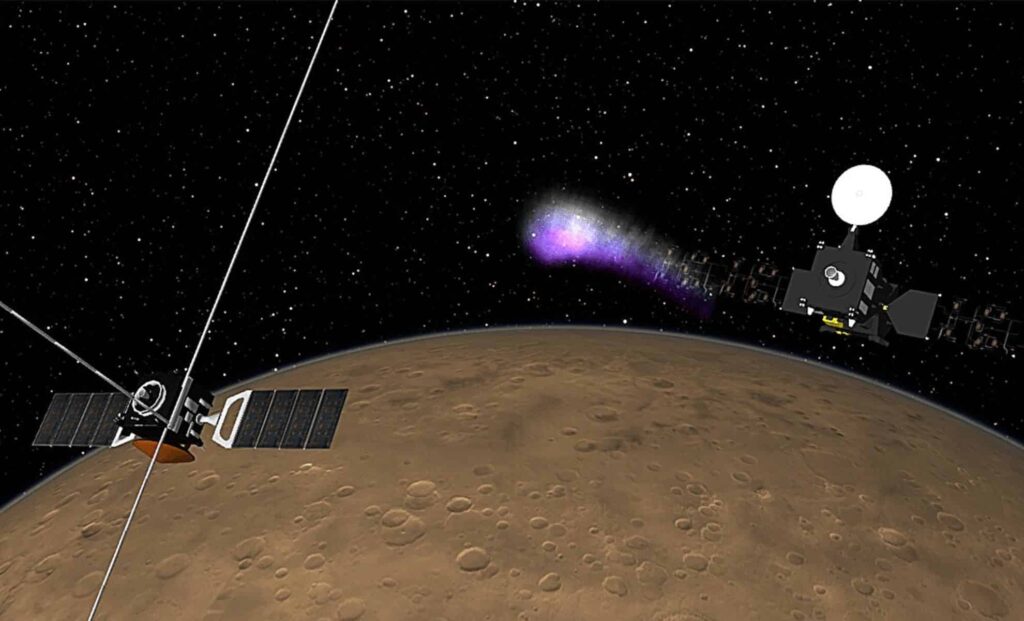
On November 13, 2020, two European Space Agency spacecraft, Mars Express and the ExoMars Trace Gas Orbiter, embarked on a mission to unravel the mysteries of Mars’ ionosphere. By employing a sophisticated technique known as mutual radio occultation, these orbiters exchanged signals while traversing behind the Red Planet. This innovative approach has yielded groundbreaking data, significantly enhancing our understanding of this vital atmospheric layer. Much like Earth’s ionosphere, Mars’ ionosphere is integral to solar radiation dynamics, atmospheric interactions, and radio communication.
The findings, published in the Journal of Geophysical Research: Planets, provide fresh insights into the electron density, temperature variations, and structural layers of the Martian ionosphere. These revelations challenge previous assumptions and pave the way for more precise future missions to Mars. This research is pivotal for advancing our comprehension of Martian atmospheric processes and their implications for scientific exploration and communication systems.
The Role of Radio Occultation in Studying the Martian Ionosphere
Radio occultation, a widely used technique in atmospheric studies, involves transmitting radio signals between a spacecraft and a receiver, often located on Earth. By observing how these signals bend as they pass through an atmosphere, scientists can glean valuable information about the ionosphere’s electron density and temperature.
However, traditional radio occultation methods face limitations when measuring the Martian ionosphere during certain times of the day, particularly around midday. This is due to the relative positions of Mars, Earth, and the Sun, which create periods where radio signals cannot effectively penetrate the Martian atmosphere. In response, scientists have turned to mutual radio occultation, which utilizes two orbiters in Mars’ orbit, enabling data collection even during these critical periods.
In this recent study, Mars Express and the ExoMars Trace Gas Orbiter successfully employed mutual radio occultation to gather 71 measurements, including 35 taken closer to midday than ever before. This marked a significant breakthrough, allowing researchers to capture ionospheric data previously inaccessible, offering new insights into this unexplored area of Martian atmospheric science.
New Discoveries: Changing Views of the Martian Ionosphere
The data provided by the Mars Express and ExoMars orbiter pair revealed several key findings about the Martian ionosphere that challenge prior assumptions. One of the most surprising results pertained to the electron density of the ionosphere’s two main layers—M1 and M2. Previous models suggested that the peak electron density in the M2 layer fluctuated significantly during the Martian day, but the new measurements indicated much less dramatic changes than previously anticipated.
Additionally, the M1 layer, previously thought to dissipate by midday, was found to remain intact during these hours, contradicting earlier assumptions about the timing of its disappearance. These discoveries provide new data that will enhance our understanding of the Martian atmosphere’s behavior throughout the day, helping scientists refine their models for future missions.
Understanding the behavior of the Martian ionosphere is also crucial for communication technologies. The ionosphere can interfere with radio waves, which could be problematic for long-range communication with future Mars explorers or satellites. This new data could lead to better strategies for dealing with these communication challenges, making future missions to Mars more efficient and reliable.
How Ionospheric Temperatures Challenge Previous Models
One of the most intriguing revelations from the study concerned ionospheric temperatures. Contrary to previous models that predicted the ionosphere would be hottest at midday due to the Sun’s direct radiation, the data suggested that ionospheric temperatures are actually highest just before Martian sunset.
The team employed a Mars climate model to simulate the ionospheric temperature dynamics. Their findings pointed to winds transporting air across the Martian atmosphere as the primary factor influencing temperature changes, rather than solar radiation directly heating the ionosphere. This discovery shifts our understanding of Martian atmospheric dynamics and could influence future research on how weather systems behave on Mars.
These findings also carry potential implications for atmospheric exploration on other planets, suggesting that similar wind-driven mechanisms could exist elsewhere in the solar system. Understanding the precise interactions between winds and the ionosphere will be crucial for designing instruments that can measure such dynamics in future planetary missions.
The announcement comes as space agencies worldwide continue to prioritize Mars exploration, with missions like NASA’s Perseverance rover and China’s Tianwen-1 probe contributing to a growing body of knowledge. As scientists refine their understanding of the Martian ionosphere, the potential for more accurate and successful missions increases, bringing humanity closer to unlocking the secrets of the Red Planet.




